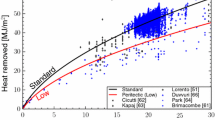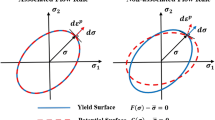Abstract
In the course of this work, an extended material model for a carbon steel sheet metal has been developed based on Hill’48 yield criterion, considering temperature-dependent plastic anisotropy coefficients. This material model is applied on a polymer injection forming process in which the sheet metal heats up to a critical forming temperature through the contact with the plastic melt. At this temperature range blue brittleness occurs. The elastic properties, the yield stress as well as the plastic anisotropy coefficients of the sheet material become significantly different compared to those at room temperature. It should be emphasized that especially temperature-dependent anisotropy coefficients are not yet considered in most common material models. With the help of the presented modelling approach a more precise modelling of the temperature-dependent carbon steel material behavior can be realised.









Similar content being viewed by others
References
Stauber R (2007) Kunststoffe im Automobilbau—Technische Lösungen und Trends, ATZ—Automobiltechnische Zeitschrift, pp 202–209
Corus Technology Bv, NL (2003) Method and device for producing a composite product and composite product produced there with, Patent WO2003/057446
Banabic D (2010) Sheet metal forming processes constitutive modeling and numerical simulation. Springer, Heidelberg
Johannaber F, Michaeli W (2002) Handbuch spritzgieen. Carl Hanser, München Wien
Vingaard M, Endelt B, Christiansen J (2007) Implementation of a material model with shear rate and temperature dependent viscosity, 6th European LS-DYNA User’s conference, vol 5, pp 213–222
Reinartz H, Mäsing R, Hirt G (2010) Hochdruckblechumformung durch Kunststoffhinterspritzen, vol 25. Aachener Stahlkolloquium, pp 165–174
Baesso R, Luchetta G (2007) Fluid structure interaction analysis in manufacturing metal/polymer macro-composites, NUMIFORM07, 908, pp 729–734
Baesso R (2008) Numerical and experimental investigation of the polymer injection forming process, Ph.D. thesis, University of Padova
Hussain MM, Trompeter M, Witulski J, Tekkaya AE (2012) An experimental and numerical investigation on polymer melt injected sheet metal forming. J Manuf Sci Eng 134(3)031005:1–13. doi:10.1115/1.4006117
Hussain MM (2013) Polymer injection sheet metal forming experiments and modeling, Ph.D. thesis, TU Dortmund
Doege E, Behrens B-A (2010) Handbuch Umformtechnik—Grundlagen, Technologien, Maschinen. Springer, Berlin
Acknowledgments
The authors thank the German Research Foundation (DFG) for the financial support of project TP4 in the research training group 1378 Manufacture, machining and qualification of hybrid material systems.
Author information
Authors and Affiliations
Corresponding author
Rights and permissions
About this article
Cite this article
Behrens, BA., Götze, T. Temperature-dependent anisotropic material modeling of the sheet metal component within the polymer injection forming process. Prod. Eng. Res. Devel. 8, 91–99 (2014). https://doi.org/10.1007/s11740-013-0511-1
Received:
Accepted:
Published:
Issue Date:
DOI: https://doi.org/10.1007/s11740-013-0511-1




